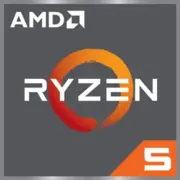AMD Ryzen 5 7640HS

AMD Ryzen 5 7640HS: A New Era of Mobile Performance
Review of the laptop processor that balances power and battery life
Architecture and Technology: Zen 4 and RDNA 3 in a Compact Package
The AMD Ryzen 5 7640HS processor, developed under the codename Phoenix, represents the quintessence of modern technology. It is manufactured using a 4nm TSMC FinFET process, allowing for 6 Zen 4 cores and 12 threads with a base frequency of 4.3 GHz and a maximum turbo frequency of up to 5.0 GHz.
Architecture Features:
- Zen 4 brought a 13% improvement in IPC (instructions per clock) compared to Zen 3, which is critical for single-threaded performance.
- 16 MB L3 cache — sufficient for fast data processing in gaming and professional applications.
- Integrated Radeon 760M graphics built on the RDNA 3 architecture: 8 compute units (CUs) with a frequency of up to 2.8 GHz. This is AMD's first iGPU with hardware Ray Tracing support, albeit in a limited capacity.
The graphics accelerator handles gaming at 1080p with low and medium settings (for instance, _CS:GO_ — 90-110 FPS, _GTA V_ — 60-70 FPS). It is also suitable for mobile workstations for rendering in Blender or editing in DaVinci Resolve due to AV1 decoding support.
Power Consumption and TDP: Flexibility over Compromises
The Ryzen 5 7640HS has a TDP of 35-54 W, making it versatile for various types of laptops.
- In 35 W mode, the processor is suitable for ultrabooks with passive cooling, maintaining quiet operation and moderate heat.
- When unlocked to 54 W (through AMD PPt settings in BIOS), it competes with the Intel Core i5/i7 H-series, showcasing peak performance in resource-intensive tasks.
Thermal output is managed by AMD Precision Boost 2, which dynamically adjusts frequencies based on temperature. For example, in a laptop with an effective cooling system (such as the Asus ROG Zephyrus G14), the processor maintains stable frequencies of 4.6-4.8 GHz under prolonged load.
Performance: From Excel to AAA Games
Geekbench 6:
- 2314 points in single-threaded tests — comparable to Intel Core i7-12700H.
- 8906 points in multi-threaded tests — close to Ryzen 7 6800H (8 cores).
Real-World Scenarios:
1. Office Work: 50 tabs in Chrome + Photoshop + Slack — CPU usage at 60-70%, temperature at 65°C.
2. Multimedia: Rendering 4K video in Premiere Pro takes 12-14 minutes (compared to 16-18 minutes with Ryzen 5 6600H).
3. Gaming: Paired with a discrete graphics card (like the RTX 4060), the performance difference between Ryzen 5 7640HS and Intel Core i5-13500H is minimal. However, when using the iGPU, AMD outperforms Intel Iris Xe by 25-40%.
Turbo Mode activates when plugged in, increasing frequencies by 10-15%. However, in battery mode, the system may limit power to save battery life.
Use Case Scenarios: Who is the Ryzen 5 7640HS Suitable For?
1. Students and Office Workers: Quick document processing, multitasking, light video editing.
2. Gamers: When paired with discrete graphics — comfortable FPS in _Cyberpunk 2077_ or _Elden Ring_.
3. Designers and Engineers: Support for professional APIs (OpenCL, Vulkan) and rendering acceleration.
Who It Is Not Suitable For:
- Enthusiasts needing maximum cores (better to choose Ryzen 9 7940HS).
- macOS users (alternative — Apple M2, but with limited gaming compatibility).
Battery Life: How Long Will the Battery Last?
With a TDP of 35 W and the use of energy-efficient modes (such as Windows 11 Battery Saver), a laptop with the Ryzen 5 7640HS lasts 7-9 hours while web surfing.
Energy-Saving Technologies:
- AMD PowerNow! — dynamic core switching.
- Adaptive Voltage Scaling — voltage reduction under low load.
However, during intensive use of the iGPU (for example, in games), the battery life drops to 2.5-3 hours.
Comparison with Competitors: AMD vs Intel vs Apple
1. Intel Core i5-13500H:
- Pros: Higher performance in single-threaded tasks (by 5-7%).
- Cons: Weaker iGPU by 30%, TDP of 45 W.
2. Apple M2:
- Pros: Better battery life (up to 15 hours).
- Cons: No support for Windows, limited game selection.
3. Previous Generation (Ryzen 5 6600H):
- Ryzen 5 7640HS is 18-22% faster thanks to Zen 4 and DDR5.
Pros and Cons of the Processor
Strengths:
- High single-threaded performance.
- Powerful integrated graphics.
- Flexible TDP management.
Weaknesses:
- Limited number of laptops with this processor (as of 2023).
- Price is 10-15% higher compared to Intel counterparts.
Recommendations for Laptop Selection
1. Type of Device:
- Ultrabooks (e.g., Lenovo Yoga Slim 7): Focus on battery life and portability.
- Gaming Laptops (ASUS TUF Gaming A16): Must have a discrete graphics card.
- Workstations (HP EliteBook 865): Choose models with 32 GB DDR5 and 1 TB SSD.
2. What to Pay Attention To:
- Cooling System: At least two fans and heat pipes.
- Display: For gaming — 120 Hz, for work — 100% sRGB coverage.
- Ports: USB4 is essential for connecting external 4K monitors.
Final Conclusion: Who is the Ryzen 5 7640HS Suitable For?
This processor is an ideal choice for those seeking a balance between performance, battery life, and price. It is suited for:
- Gamers who want to play without being plugged in (thanks to Radeon 760M).
- Freelancers working in cafes or coworking spaces.
- Students balancing studies and entertainment.
Key Benefits:
- The power of Zen 4 in a compact package.
- Flexibility of use — from energy-saving to turbo mode.
- Future-proof with support for DDR5 and PCIe 5.0.
If you're looking for a laptop for the next 3-4 years, the Ryzen 5 7640HS is one of the best options in the mid-range price segment.
Basic
CPU Specifications
Memory Specifications
GPU Specifications
Miscellaneous
Benchmarks
Compared to Other CPU
Share in social media
Or Link To Us
<a href="https://cputronic.com/cpu/amd-ryzen-5-7640hs" target="_blank">AMD Ryzen 5 7640HS</a>